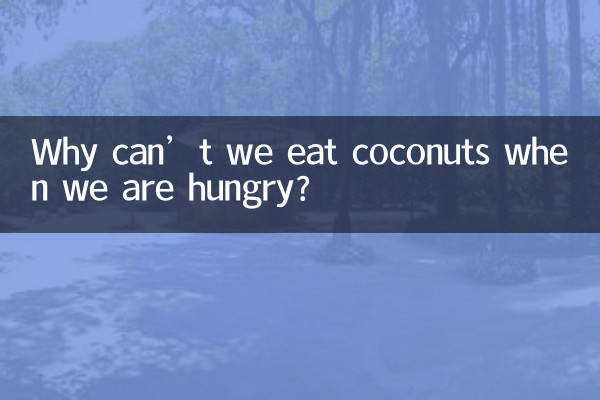Why can’t we eat coconuts when we are hungry?
During times of famine, people often look for any possible source of food to survive. However, some seemingly edible foods may actually harbor significant risks. As a common tropical fruit, why can't coconut be used as the main food source during times of famine? This article will answer this question for you through structured data and analysis.
1. Nutritional value and limitations of coconut

Although coconut is rich in water and some nutrients, its nutritional content is not sufficient to support long-term survival needs. Here’s a comparison of the nutritional content of coconut and other common foods:
| food | Calories (kcal/100g) | Protein (g/100g) | Fat (g/100g) | Carbohydrates (g/100g) |
|---|---|---|---|---|
| coconut | 354 | 3.3 | 33.5 | 15.2 |
| Rice | 130 | 2.7 | 0.3 | 28.2 |
| potatoes | 77 | 2.0 | 0.1 | 17.5 |
As can be seen from the table, coconut's calories, although higher, mainly come from fat and are lower in protein and carbohydrates. Long-term reliance on coconut may lead to nutritional imbalances, especially insufficient protein intake.
2. Risks of eating coconuts
In times of famine, coconut consumption also carries the following risks:
| Risk type | Specific performance |
|---|---|
| digestive problems | Coconuts are rich in fat and excessive consumption may cause diarrhea or indigestion |
| Single nutrition | Lack of multiple vitamins and minerals, long-term consumption can lead to malnutrition |
| Obtain difficulty | Coconuts usually grow in tropical areas and are difficult to obtain in large quantities in non-tropical areas. |
3. Historical cases and lessons
There have been cases in history of people trying to survive on coconuts during times of famine, but the results were often unsatisfactory. For example:
| event | result |
|---|---|
| Famine on a Pacific island | Residents’ long-term dependence on coconuts has led to a high incidence of protein deficiency |
| After a disaster in a certain region of Southeast Asia | Coconut as main food source causes massive digestive diseases |
4. Alternative food suggestions
In times of famine, the following foods should be given priority:
| food type | Advantages |
|---|---|
| Cereals | Provides stable carbohydrates and is easy to store |
| beans | Rich in protein and nutritionally balanced |
| root vegetables | Easy to grow, provides multiple vitamins |
5. Conclusion
Although coconut can provide moisture and some energy in the short term, from a long-term survival perspective, it cannot be used as a primary food source during times of famine. The imbalance of its nutritional structure, potential digestive risks, and difficulty in obtaining it all limit the usefulness of coconuts in times of famine. When faced with food shortages, priority should be given to more nutritionally balanced and easily accessible food sources.
Through the above analysis, we can clearly understand why coconuts cannot be relied on as the main food during times of famine. This conclusion is not only based on scientific data, but also verified by historical experience.

check the details

check the details